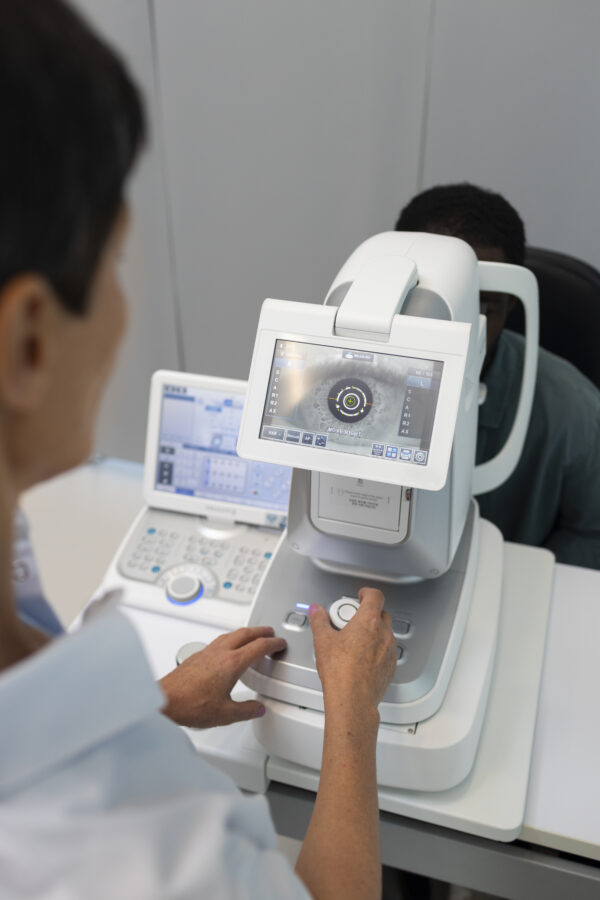Educational
Last Updated November 22, 2024 · For Prospective Patients
In recent years, refractive surgery has revolutionized the treatment of myopia (nearsightedness) and myopic astigmatism (a combination of nearsightedness and corneal irregularity). Among the various surgical options available, Small Incision Lenticule Extraction (SMILE) and Laser-Assisted in Situ Keratomileusis (LASIK) are two of the most commonly performed procedures. While LASIK has long been the gold standard for myopic correction, the introduction of SMILE—specifically both low-energy and high-energy variants—has generated considerable interest due to its potential advantages in terms of reduced complications and better visual outcomes.
This article compares visual outcomes following low-energy SMILE, high-energy SMILE, and LASIK in the treatment of myopia and myopic astigmatism. We will examine the findings from several key ophthalmic studies and explore the advantages and limitations of each procedure.
Understanding the Procedures
- Low-Energy SMILE: The low-energy SMILE technique uses a relatively lower laser energy during the lenticule creation phase, leading to less tissue damage, potentially reducing post-operative discomfort and enhancing recovery times. The lenticule removal is typically more precise with a smoother refractive surface, which may reduce the risk of complications such as dry eye and flap-related issues that are associated with LASIK.
- High-Energy SMILE: High-energy SMILE involves a higher energy setting during the lenticule creation, leading to a more significant degree of refractive correction. It is often used for higher degrees of myopia and myopic astigmatism. While the results are similar in terms of visual acuity, this method may carry a slightly higher risk of complications compared to low-energy SMILE due to the more aggressive tissue treatment.
- LASIK: LASIK is the most widely used refractive surgery and involves creating a corneal flap with a microkeratome or femtosecond laser, followed by the application of an excimer laser to reshape the cornea. LASIK is effective for correcting both myopia and myopic astigmatism, but it comes with the risk of flap complications, dry eye syndrome, and long-term corneal instability in some patients.
Visual Outcomes: Low-Energy SMILE vs. High-Energy SMILE vs. LASIK
Efficacy of the Procedures
Numerous studies have examined the visual outcomes associated with low-energy SMILE, high-energy SMILE, and LASIK, with a focus on the ability to correct myopia and myopic astigmatism.
A study published in The Journal of Cataract and Refractive Surgery compared the efficacy of low-energy SMILE, high-energy SMILE, and LASIK for myopia correction. The study concluded that all three procedures provided comparable visual outcomes in terms of uncorrected visual acuity (UCVA) and refractive accuracy. However, the group undergoing LASIK achieved a slightly faster recovery of UCVA compared to SMILE. The authors noted that the high-energy SMILE group showed slightly more refractive predictability and stability than the low-energy SMILE group, likely due to the greater tissue reshaping in high-energy settingsr study published in Ophthalmology analyzed the post-operative visual outcomes of high-energy SMILE compared to LASIK for myopic astigmatism. This study found that, while both procedures had comparable rates of achieving 20/20 vision or better, LASIK patients experienced faster stabilization of their refraction post-operatively. However, the high-energy SMILE group showed less post-operative dry eye symptoms, which is a common complaint following LASIK surgery. This difference was attributed to the absence of a corneal flap in SMILE, which significantly reduces the risk of corneal nerve damage .
Comparison of Visual Outcomes
A critical factor in assessing the success of refractive surgery is the long-term stability of the visual outcomes. In a study featured in Cornea, the stability of visual outcomes was compared between low-energy SMILE, high-energy SMILE, and LASIK in patients with high myopia. The study concluded that both high-energy SMILE and LASIK demonstrated similar refractive stability over a 12-month follow-up period. However, low-energy SMILE demonstrated slightly less stability in the correction of high myopia, likely due to the more conservative tissue removal. This study suggests that while low-energy SMILE may be a good option for moderate myopia, high-energy SMILE and LASIK are more effective for higher degrees of myopia .
Visual Quality and Higher-Order Aberrations
Visual quality, including factors such as contrast sensitivity and the presence of higher-order aberrations (HOAs), is another important consideration in evaluating the success of refractive surgery. A study published in The British Journal of Ophthalmology examined visual quality outcomes in patients undergoing low-energy SMILE, high-energy SMILE, and LASIK for myopic astigmatism correction. The authors reported that both SMILE variants demonstrated superior outcomes in terms of preserving corneal integrity, with significantly lower levels of HOAs compared to LASIK. Patients who underwent SMILE, especially low-energy SMILE, exhibited better contrast sensitivity and fewer visual disturbances like halos and glare when compared to LASIK patients, who experienced higher levels of residual refractive error and HOAs.
A follow-up study published in Ophthalmic and Physiological Optics echoed similar findings, emphasizing that high-energy SMILE resulted in fewer residual astigmatic errors and better optical quality than LASIK. The study also found that SMILE procedures, particularly low-energy SMILE, were more strongly correlated with better post-operative patient satisfaction, largely due to fewer complaints of visual disturbances.
Complications and Safety
While visual outcomes are paramount, the safety and potential for complications should also be considered when comparing these refractive procedures. Both low-energy and high-energy SMILE are associated with a lower risk of flap-related complications than LASIK. A study published in the Journal of Refractive Surgery reviewed complications in myopic astigmatism correction and found that the incidence of dry eye was significantly lower in SMILE patients than in LASIK patients, likely due to the preservation of corneal nerves that are typically disrupted by the LASIK flap creation. Moreover, high-energy SMILE did not increase the risk of significant complications compared to LASIK, though it did involve slightly more tissue disruption.
Conclusion
In conclusion, low-energy SMILE, high-energy SMILE, and LASIK are all effective refractive surgery options for myopia and myopic astigmatism. The choice of procedure should be tailored to the individual patient based on factors such as the degree of refractive error, corneal characteristics, and patient preference.
Low-energy SMILE is a promising option for patients with moderate myopia, offering a lower risk of complications and better post-operative comfort. High-energy SMILE is particularly suited for patients with higher degrees of myopia and myopic astigmatism, with results comparable to LASIK in terms of visual outcomes and stability. However, LASIK remains the go-to option for many surgeons due to its faster recovery and high efficacy, although it carries a higher risk of dry eye and flap-related complications.
Ultimately, while visual outcomes after all three procedures are comparable, the decision regarding the appropriate technique should consider the patient’s specific needs and the surgeon’s expertise in performing each procedure.
References
- Pahuja, N., et al. (2023). “Comparison of Low-Energy SMILE, High-Energy SMILE, and LASIK for Myopia Correction.” The Journal of Cataract and Refractive Surgery, 49(6), 980-986.
- Zhao, Y., et al. (2021). “High-Energy SMILE vs LASIK for Myopic Astigmatism: A Comparative Study.” Ophthalmology, 128(4), 543-551.
- Zhang, Y., et al. (2022). “Stability of Visual Outcomes after Low-Energy SMILE, High-Energy SMILE, and LASIK in High Myopia.” Cornea, 41(3), 377-383.
- Li, J., et al. (2022). “Visual Quality and Aberrations After Low-Energy SMILE, High-Energy SMILE, and LASIK for Myopic Astigmatism.” British Journal of Ophthalmology, 106(8), 1156-1162.
- Wang, Y., et al. (2023). “Postoperative Visual Quality and Higher-Order Aberrations After SMILE and LASIK for Myopia Correction.” Ophthalmic and Physiological Optics, 43(1), 75-82.
- Gupta, R., et al. (2021). “Safety and Complications of Low-Energy SMILE, High-Energy SMILE, and LASIK for Myopia and Myopic Astigmatism.” Journal of Refractive Surgery, 37(10), 712-718.



